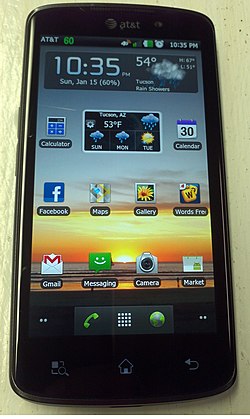 LG Optimus LTE | |
| Manufacturer | LG Electronics |
|---|---|
| First released | |
| Availability by region | US: Q4-2011 |
| Predecessor | LG Optimus 3D LG Revolution (Verizon Wireless) |
| Successor | LG Optimus LTE 2 |
| Form factor | Touchscreen smartphone |
| Dimensions | Different by country |
| Weight | Different by country |
| Operating system | Android 2.3.5 Gingerbread, upgrade to 4.0 ICS |
| CPU | Qualcomm Snapdragon S3 (dual-core 1.5 GHz) |
| Memory | 1 GB RAM |
| Storage | 16 GB on board, supports up to 32 GB microSDHC |
| Battery | 1830 mAh Talk time
Standby time
|
| Rear camera | 8 MP AF, digital zoom with LED Flash |
| Front camera | 1.3 MP imager for video chat, self image capture |
| Display | 4.5-inch 1280×720 px IPS LCD at 329 ppi, 16 M colors, |
| Connectivity | LTE 700 MHz, Class 17, GSM 850, 900, 1,900, and 1,800 MHz, audio jack 3.5 mm, Micro USB 2.0 HS, corporate sync, BOTA, Wi-Fi 2.4 GHz, 5 GHz 802.11 b/g/n, Bluetooth 3.0, HSPA at 14.4 Mbit/s |
| Data inputs | Multi-touch capacitive touchscreen display, accelerometer, ambient light sensor, proximity sensor, |
| Other | aGPS with Google Maps, Google Street View, Google Latitude, Android Market |
| Website | |
The LG Optimus LTE is one of the first released 4G LTE smartphones running under the Android operating system that is manufactured by LG. It was first released on October 10, 2011 in South Korea.